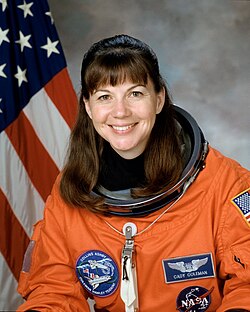Catherine G. Coleman
| Catherine G. Coleman | |
 Catherine Grace "Cady" Coleman. | |
| NASA-astronaut | |
|---|---|
| Tillstånd | Aktiv |
| Född | 14 december 1960 Charleston, South Carolina |
| Andra yrken | Kemist |
| Tid i rymden | 180 dagar, 4 timmar |
| Urvalsgrupp | Astronautgrupp 14 |
| Uppdrag | STS-73, STS-93, Sojuz TMA-20, Expedition 26/27 |
| Uppdragsemblem | |
Catherine Grace Coleman, född 14 december 1960 i Charleston, South Carolina, är en amerikansk astronaut uttagen i astronautgrupp 14 den 5 december 1992.
Rymdfärder
Referenser
”Biographical Data” (på engelska) (PDF). NASA. december 2016. https://www.nasa.gov/wp-content/uploads/2019/03/coleman.pdf?emrc=a0cf0a. Läst 3 maj 2024.
Media som används på denna webbplats
The crew patch of STS-73, the second flight of the United States Microgravity Laboratory (USML-2), depicts the Space Shuttle Columbia in the vastness of space. In the foreground are the classic regular polyhedrons that were investigated by Plato and later Euclid. The Pythagoreans were also fascinated by the symmetrical three-dimensional objects whose sides are the same regular polygon. The tetrahedron, the cube, the octahedron, and the icosahedron were each associated with the Natural Elements of that time: fire (on this mission represented as combustion science); Earth (crystallography), air and water (fluid physics). An additional icon shown as the infinity symbol was added to further convey the discipline of fluid mechanics. The shape of the emblem represents a fifth polyhedron, a dodecahedron, which the Pythagoreans thought corresponded to a fifth element that represented the cosmos.
Astronaut Catherine G. Coleman, mission specialist
In the foreground of the patch, the International Space Station is prominently displayed to acknowledge the efforts of the entire International Space Station (ISS) team - both the crews who have built and operated it, and the team of scientists, engineers, and support personnel on Earth who have provided a foundation for each successful mission. Their efforts and accomplishments have demonstrated the space station's capabilities as a technology test bed and a science laboratory, as well as a path to the human exploration of our solar system and beyond. The ISS is shown with the European Space Agency's (ESA) Automated Transfer Vehicle (ATV-2), the Johannes Kepler, docked to resupply it with experiments, food, water, and fuel for Expedition 26 and beyond. This Expedition 26 patch represents the teamwork among the international partners - USA, Russia, Japan, Canada, and the ESA - and the ongoing commitment from each partner to build, improve, and utilize the ISS. Prominently displayed in the background is our home planet, Earth - the focus of much of our exploration and research on our outpost in space. The two stars symbolize two Soyuz spacecraft, each one carrying a three-member crew, who for four months will work and live together aboard the ISS as Expedition 26. The patch shows the crewmembers' names, and it's framed with the flags of their countries of origin - United States, Russia, and Italy.
Space shuttle mission patch
The Expedition 27 patch depicts the International Space Station (ISS) prominently orbiting Earth, continuing its mission for science, technology and education. The ISS is an ever-present reminder of the cooperation between the United States, Russia, Japan, Canada, and the European Space Agency (ESA) – and of the scientific, technical, and cultural achievements that have resulted from that unique teamwork. The ISS is shown in its completed status with the latest addition of the Alpha Magnetic Spectrometer (AMS), and with two resupply vehicles docked at each end of the station. The Southern Cross Constellation is also show in the foreground and its five stars, along with the sun, symbolize the six international crew members that live and work on the space station. The Southern Cross is one of the smallest modern constellations, and also one of the most distinctive. It has cultural significance all over the world and inspires teams to push the boundaries of their worlds, both in space and on the ground.





